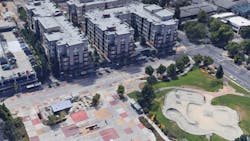Transit oriented developments versus Park-and-rides: Which is appropriate where?
Mineta Transportation Institute (MTI) has published its latest research, Transit Oriented Development (TOD) and Park-and-Ride: Which is Appropriate Where?, which analyzes data from three major U.S. transit agencies to give insight into where and how these strategies can support greater transit ridership even during the COVID-19 pandemic.
Using data from Santa Clara Valley Transportation Authority (VTA) serving San Jose, Calif., and a service territory of 1,954,000; King County Metro (KC Metro) serving Seattle, Wash., and a service territory of 2,150,000; and Los Angeles County Metropolitan Transportation Authority (L.A. Metro) with a service territory of 8,341,000, the research team performed quantitative analysis to compare the two strategies.
Significant findings include:
- Large park-and-ride (PnR) structures within a quarter mile of a stop significantly increase ridership, from a 101-percent increase for L.A. Metro to a 419-percent increase for KC Metro.
- Expanding PnR facilities also increases ridership. Adding 100 new parking spaces to existing PnR facilities increases ridership from a nine-percent increase for L.A. Metro to a 44-percent increase for KC Metro.
- Adding new housing provides a lower boost in ridership. Adding 100 new housing units leads to a five-percent to 11-percent increase in ridership.
Overall, the data shows that parking is surprisingly important, approximately two to four times more. Furthermore, PnR space is usually cheaper and faster to add than a TOD housing unit. Yet, current public policy in all three regions emphasizes TOD over PnR, especially in areas where PnR was not well used prior to the 2020 pandemic. Supporting TOD helps meet climate goals through a reduction in driving and by creating vibrant walkable communities, but PnR structures, carefully configured to avoid negative pedestrian impacts, cannot be overlooked. High volume points of boarding at PnRs are also efficient locations for coach capacity controls, mask compliance, and other public health measures.
“When asking how much to emphasize parking or housing near transit stations to increase ridership, it’s clear that less space and lower infrastructure costs are associated with creating a parking space than a housing unit,” explain the authors, while also noting “the funding sources for each are usually different.”
This research can inform public policy about the benefits of these two competing strategies. While both strategies can positively affect climate goals, based on econometric analysis, park-and-ride is a more efficient and effective way to grow ridership than transit-oriented development, especially outside of central city neighborhoods.
MTI will feature this research as part of its MTI Research Snaps webinar series on March 4.
